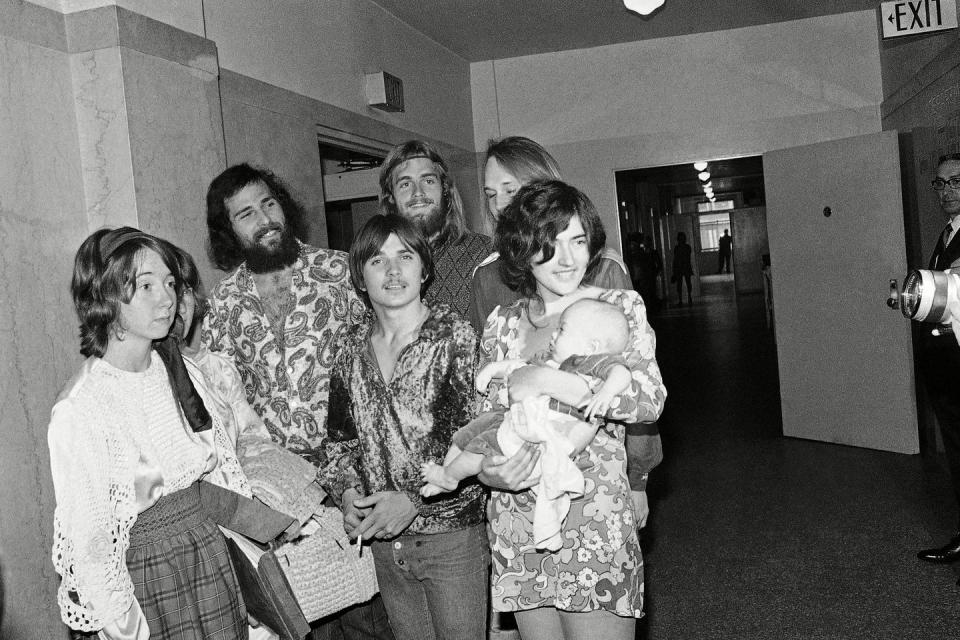Here's The True Story Behind Lena Dunham's Unnerving 'Once Upon A Time In Hollywood' Character

In Once Upon a Time in Hollywood, a fictionalised version of Charles Manson and his followers play a supporting role to the story of two fictional characters (Leonardo DiCaprio and Brad Pitt) in the entertainment industry. Quentin Tarantino took a lot of liberties with the story of the so-called Manson Family, some of whom ultimately carried out the murders of actress Sharon Tate and four others the night of 8 August, 1969. But many of the characters in the movie are based on real people.
Lena Dunham has a smaller as Gypsy, who appears to be based on the Manson follower Catherine "Gypsy" Share. The real Share has only done a handful of interviews over the years. But in an upcoming special on Oxygen, Manson: The Women, the now 76-year-old, speaks out about her relationship with Manson—and what happened before and after the Cielo Drive massacre.
Here’s how Share’s experience sheds light on the real events that inspired Once Upon a Time.
Share, who was born in France but moved to the U.S. as a child, met Manson in the late 1960s after the death of her mother and stepmother. Manson was traveling across Southern California with his growing group of mostly teenage girls, many of whom had run away from home or lost parents, when Share encountered him.
“One day a car drove up, an old beat-up Chevy, with an old cowboy in it and four girls, and that’s how I met Charlie,” she says in the Oxygen special, which airs August 10. “He was fun-loving and everyone seemed very peaceful and happy. I felt accepted. It was kind of like a dream come true. I was an orphan so I was looking for family. So I said, I'm staying, and I never left.”
Manson spent years in prison before leading his pseudo-religious cult in the late ’60s. Manson, a wannabe musician, had studied both religion and tools of influence which he used to manipulate the mostly middle-class girls he preyed on.

“He just made you feel good about yourself. He gave women what they needed and wanted in a lot of different ways,” Share said on the Australian version of 60 Minutes earlier this year. “I thought he was the closest thing to Jesus. I didn’t think he was actually Jesus Christ. He just seemed like he knew everything and he seemed at peace and happy all the time so we listened to everything he said like it was gospel.”
Manson, Share and the rest of the followers moved onto the ranch of former cowboy actor George Spahn in the late 1960s. To pay for room and board, the women did chores around the ranch.
It was Share who enticed 19-year-old Leslie Van Houten to join the group, Share later said in testimony about Van Houten. Van Houten later became one of the followers charged with murdering at the direction of Manson.
The ranch grew to have about 100 residents following the teachings of Manson. He used his influence to spew hatred and eventually inspire violence. Manson, a virulent racist, convinced his followers a race war was on the horizon.
“It was just a very slow all-for-one and one-for-all and then it became that we needed to survive because something terrible was going to come down,” Share said on the Australian 60 Minutes. “There was going to be a race war and everyone was going to fight everyone.”
To ignite his doomsday scenario in which white people and black people would be pitted against one another, which he dubbed Helter Skelter, Manson ordered four of his followers to kill everyone at 10050 Cielo Drive, which included Tate, who was eight and a half months pregnant, hair stylist Jay Sebring, Steven Parent, Abigail Folger, and Voytek Frykowski. They attempted to stage the crime scene in such a way that would convince the authorities members of the Black Panthers were the perpetrators.
Share wasn’t a part of the murders that night, or the killing of Leno and Rosemary LaBianca, which followed.

Afterwards, however, she went to the courthouse in support of Manson and those being charged. Share and the other supporters were kicked out of the courthouse, so they moved their vigil to the street corner.
“Of course everything was about Charlie on the corner, so it was about getting Charlie out,” Share says in the special. “He was the person who didn’t mind who got thrown under the bus, who gets killed, who gets blamed, as long as he survives. It’s pure self preservation.”
Manson, Tex Watson, Patricia Krenwinkel, Susan Atkins, and Van Houten went to prison for the murders. Manson died in prison in 2017.
Today, Share says she feels “very, very bad” for the victims and their families. In other interviews, she’s painted her former “family” members-turned-murderers as victims, as well. Share testified at Van Houten's 2017 parole hearing, BBC reported, saying Manson wouldn't let followers leave the ranch and that he threatened violence.
"Manson made a lot of victims besides the ones he killed," Share said in 2009. "He destroyed lives. There are people sitting in prison who wouldn't be there except for him. He took all of our lives."
You Might Also Like

